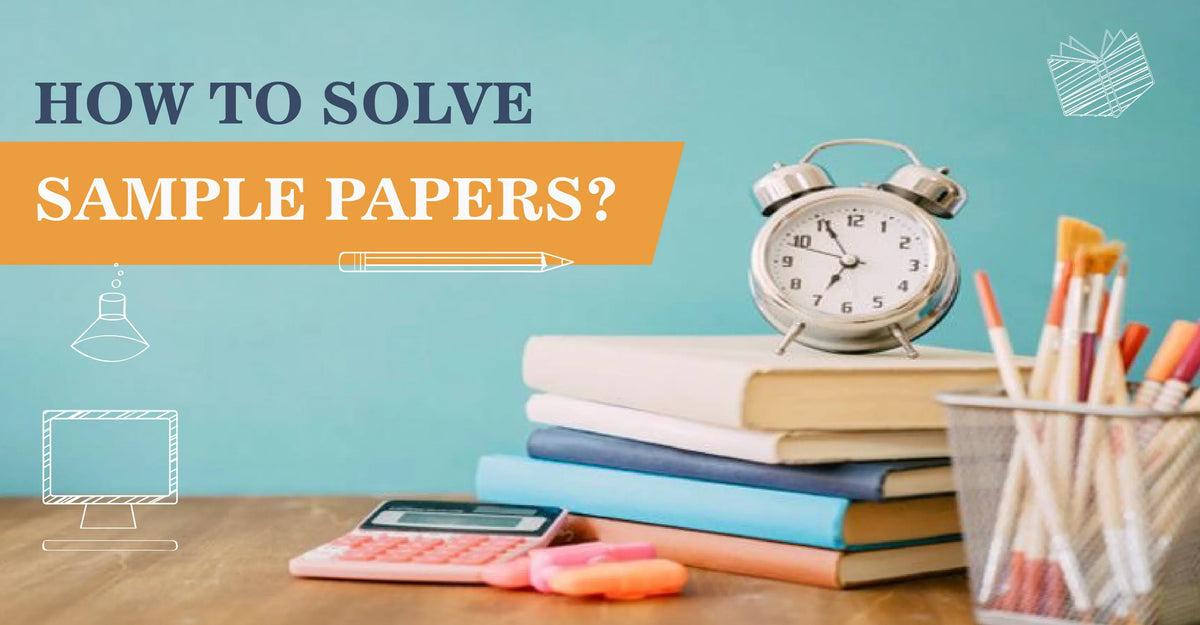Solving sample papers is one of the most effective strategies for students preparing for exams—whether school-level board exams, entrance tests like NEET or JEE, or competitive exams like UPSC, GRE, or IELTS. However, not everyone uses sample papers the right way. Many students either rush through them or treat them as optional, missing out on their full benefits. This blog breaks down the right approach to solving sample papers in a way that is helpful, simple, and suitable for learners of all ages.

Why Solving Sample Papers Matters
Sample papers are practice tests designed to reflect the format, difficulty, and style of the actual exam. They help students:
- Understand the exam pattern and marking scheme
- Familiarise themselves with the types of questions
- Improve time management
- Identify strong and weak areas
- Build confidence through repeated practice
According to a study by the Journal of Educational Psychology, students who practised with previous or sample exam papers performed 25% better than those who only studied theory (Dunlosky et al., 2013).
Step-by-Step Guide to Solving Sample Papers the Right Way
1. Start After Completing the Syllabus
One common mistake is starting sample papers too early. Make sure you have completed at least 70–80% of the syllabus before attempting full-length papers. Otherwise, you’ll waste time struggling with questions from topics you haven’t studied yet. However, it’s fine to practice individual topic-based questions along the way.
Tip: Use chapter-wise sample questions while studying each subject and move on to full sample papers only after a complete revision.
2. Simulate Real Exam Conditions
To get the best results from a sample paper, treat it like a real exam:
- Choose a quiet place
- Set a timer according to the official exam duration
- Keep only allowed stationery and tools
- Avoid interruptions (no phone, no distractions)
Simulating the environment helps you build exam temperament, stay calm under pressure, and manage time better.
3. Stick to Time Limits
Time management is a crucial skill. When solving a sample paper, stick strictly to the exam’s time limit. For example, if the real exam is three hours long, you should complete the sample paper within the same time.
This helps you gauge:
- How fast do you need to attempt questions
- Which sections take the most time
- When to move on if you’re stuck on a question
Use a clock or stopwatch to time yourself. Practice multiple sample papers to improve your speed and accuracy.
4. Analyse Your Performance
Many students finish a sample paper and move on without review. That’s a big mistake.
After solving the paper:
- Check answers carefully using a marking scheme or solution guide
- Identify which questions were incorrect
- Understand why mistakes were made—was it due to a lack of knowledge, misreading, or poor time management?
This step turns practice into valuable learning. Keep a notebook or spreadsheet to record your performance, including marks scored, topics where errors occurred, and areas that need revision.
5. Revise Weak Areas
The purpose of sample papers isn’t just to test what you know—it’s to identify what you don’t. Once you spot weak areas, revisit those topics.
For example, if you’re repeatedly making mistakes in algebra questions, it’s a sign you need to revise that chapter or practice more problems.
This cycle—practice → review → revise → re-practice—is the most effective way to improve scores.
6. Solve a Variety of Papers
Don’t rely on just one source. Use different sample paper books or platforms to get exposure to a wider range of question types. Many coaching institutes and educational websites like:
- BYJU’S (byjus.com)
- Toppr (toppr.com)
- CBSE/NTA official sample papers (cbseacademic.nic.in)
- Khan Academy (khanacademy.org)
Offer high-quality sample papers with solutions.
Using multiple resources ensures you are not just memorising questions, but truly understanding the subject.
7. Use Marking Schemes and Answer Keys Wisely
After solving, refer to the official marking schemes or teacher-approved answer keys. This helps you learn the ideal way to structure answers and what examiners look for.
For descriptive or essay-based exams like UPSC or board exams, presentation, keywords, and clarity matter. Going through top-scoring answers can teach you how to frame your responses more effectively.
8. Don’t Skip Mental and Physical Preparation
While solving sample papers improves academic readiness, don’t ignore your health. Exam performance is also influenced by:
- Sleep – Ensure 7–8 hours of rest
- Diet – Eat nutritious meals
- Breaks – Take short breaks while practising to avoid burnout
- Mindfulness – Light exercise or meditation helps reduce anxiety
Preparing both your mind and body makes your practice sessions more productive.
9. Subject-Specific Tips
Math and Science:
- Focus on accuracy and steps.
- Practice calculations without a calculator (unless allowed).
- Time each section and improve speed.
Languages (English, Hindi, etc.):
- Pay attention to grammar, spelling, and sentence structure.
- Practice comprehension and essay writing under time constraints.
Social Studies:
- Practice writing point-wise answers with dates/facts.
- Use maps and timelines wherever applicable.
Competitive Exams:
- Focus on mock tests with negative marking to simulate real pressure.
- Analyse previous years’ cut-offs and patterns.
Common Mistakes to Avoid
- Starting late: Don’t wait until the week before the exam. Start at least 4–6 weeks in advance.
- Ignoring analysis: Without review, practice becomes mechanical.
- Practising without a plan: Set goals—e.g., “3 papers this week, one in each subject.”
- Using shortcuts or peeking at answers: This defeats the purpose.
Final Thoughts
Sample papers are not just for testing—they are for training. When solved the right way, they become your greatest ally in exam preparation. The goal is not just to get correct answers, but to develop a strategy for approaching exams smartly and confidently.
Start early, be consistent, learn from every attempt, and soon you’ll notice a big improvement in both your preparation and your mindset.
The Best Way to Make a Study Group in College
References
- Dunlosky, J., Rawson, K. A., Marsh, E. J., Nathan, M. J., & Willingham, D. T. (2013). Improving Students’ Learning With Effective Learning Techniques: Promising Directions From Cognitive and Educational Psychology. Psychological Science in the Public Interest, 14(1), 4–58. DOI:10.1177/1529100612453266
- Central Board of Secondary Education. Sample Papers and Marking Schemes. cbseacademic. nic. in
- BYJU’S Learning App. Exam Preparation Tools. byjus.com
- Khan Academy: Free Practice Tests. khanacademy.org

